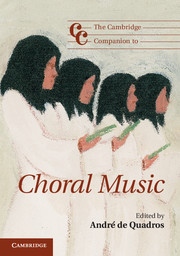Book contents
- Frontmatter
- 1 Introduction: choral music – a dynamic global genre
- Part I Choral music: history and context
- Part II Choral music the world over
- 6 Choral music and tradition in Europe and Israel
- 7 Canada's choral landscape
- 8 A multiplicity of voices: choral music in the United States
- 9 A hundred years of choral music in Latin America 1908–2008
- 10 Choral music in East Asia: China, Japan, and Korea
- 11 New voices in ancient lands: choral music in South and Southeast Asia
- 12 From chanting the Quran to singing oratorio: choral music in West and Central Asia
- 13 Voices of the Pacific: the (ch)oral traditions of Oceania
- 14 Choral music in Africa: history, content, and performance practice
- Part III Choral philosophy, practice, and pedagogy
- Notes
- Select bibliography
- Index
- Cambridge Companions to Music
8 - A multiplicity of voices: choral music in the United States
from Part II - Choral music the world over
Published online by Cambridge University Press: 28 September 2012
- Frontmatter
- 1 Introduction: choral music – a dynamic global genre
- Part I Choral music: history and context
- Part II Choral music the world over
- 6 Choral music and tradition in Europe and Israel
- 7 Canada's choral landscape
- 8 A multiplicity of voices: choral music in the United States
- 9 A hundred years of choral music in Latin America 1908–2008
- 10 Choral music in East Asia: China, Japan, and Korea
- 11 New voices in ancient lands: choral music in South and Southeast Asia
- 12 From chanting the Quran to singing oratorio: choral music in West and Central Asia
- 13 Voices of the Pacific: the (ch)oral traditions of Oceania
- 14 Choral music in Africa: history, content, and performance practice
- Part III Choral philosophy, practice, and pedagogy
- Notes
- Select bibliography
- Index
- Cambridge Companions to Music
Summary
Drawing on a diverse and evolving population, the choral culture of the United States reflects the multiplicity of contemporary American society. Whether in worship, protest, recreational, or concert settings, people of all ages, ethnic backgrounds, and creeds comprise the country's dynamic singing community. According to the 2009 Chorus Impact Study published by Chorus America, more people in the United States are involved in choral singing than in any other performing art. Approximately 22.9 percent of American households have at least one member in a chorus. An estimated 42.6 million singers participate in one or more of 270,000 religious, academic, children's, community, and professional choirs. This abundant choral landscape is enriched by America's diverse population of composers and supported by a variety of service organizations and advocacy groups.
Religious communities
Singing was an important part of religious life in the colonial era, but was largely unorganized. In the eighteenth century, musicians such as composer William Billings (1746–1800) spearheaded the establishment of “singing schools.” These traveling schools, lasting from a few days to several weeks in length, moved from town to town with the aim of improving the quality of congregational singing. Participants learned rudiments of vocal production, solmization, and part-singing. Alumni of the schools established church and community choirs throughout New England and the northeast United States. By the 1780s, organized choirs had become very widespread across New England.
- Type
- Chapter
- Information
- The Cambridge Companion to Choral Music , pp. 115 - 129Publisher: Cambridge University PressPrint publication year: 2012



